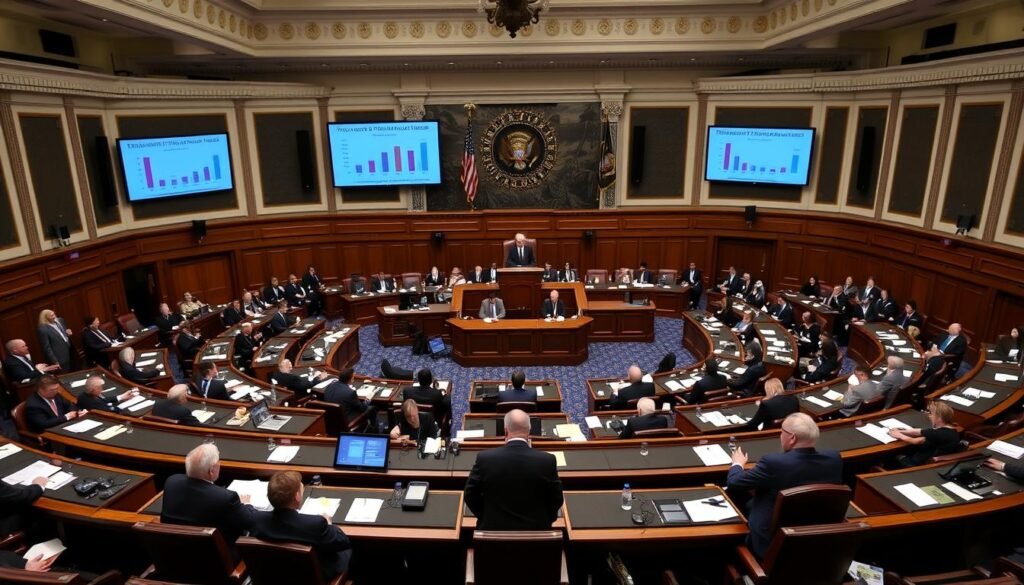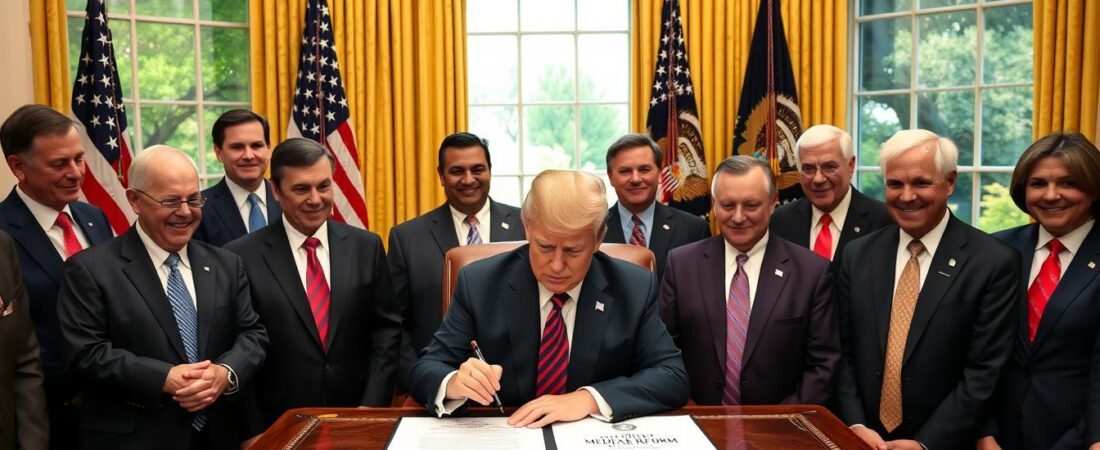President Donald Trump’s sweeping domestic policy package, dubbed the “One Big Beautiful Bill,” has passed through Congress with significant implications for America’s healthcare landscape. At its core, the legislation contains approximately $1 trillion in Medicaid cuts over the next decade, potentially affecting millions of Americans who rely on the program for healthcare coverage. This comprehensive analysis examines how the Trump Medicaid Bill compares to previous administrations’ approaches, what specific changes it introduces, and what these reforms could mean for beneficiaries, healthcare providers, and the broader healthcare system.
Understanding the Trump Medicaid Bill: Key Components
President Trump signs the “One Big Beautiful Bill” containing significant Medicaid reforms
The Trump administration’s Medicaid reform package represents one of the most substantial overhauls of the program since its inception. According to the Congressional Budget Office (CBO), the legislation would reduce federal Medicaid spending by approximately $930 billion over the next decade. These cuts are part of a broader fiscal package that includes $4 trillion in tax cuts, creating what critics describe as a significant redistribution of resources.
The bill introduces several key changes to Medicaid:
- Mandatory work requirements of 80 hours per month for able-bodied adults under 65
- Restrictions on state-levied provider fees that help fund Medicaid
- Reduced federal reimbursement rates for states
- Potential “trigger” mechanisms in states that could automatically end Medicaid expansion
Dr. Joan Akler, executive director of Georgetown University’s Center for Children and Families, describes it as “the largest rollback of healthcare coverage that we’ve ever seen and all in service of an agenda to drive tax cuts that will disproportionately benefit wealthy people and corporations.”
Historical Context: How Trump’s Approach Compares to Previous Administrations
Obama’s ACA Expansion
The Affordable Care Act of 2010 represented the largest expansion of Medicaid in the program’s history. It extended eligibility to adults earning up to 138% of the federal poverty level ($36,777 for a family of three). Federal funding covered 90% of expansion costs, with states covering the remaining 10%.
Under the Obama administration, Medicaid enrollment grew from 56 million in 2010 to 71 million by 2016, according to the Centers for Medicare and Medicaid Services (CMS).
Trump’s Structural Reform
In contrast, the Trump approach focuses on fiscal constraints and state flexibility. The new legislation would fundamentally alter the funding structure, potentially reducing enrollment by nearly 12 million people by 2034, according to CBO estimates.
Unlike previous Republican proposals that sought to convert Medicaid to block grants, this legislation maintains the program’s basic structure while significantly reducing federal financial support and adding administrative requirements.
Dr. Sara Rosenbaum, Professor of Health Law and Policy at George Washington University, notes: “The fundamental difference between the Obama and Trump approaches to Medicaid is that one viewed the program as a vehicle for expanding coverage, while the other sees it primarily as a fiscal burden requiring containment.”
The $1 Trillion Question: Analyzing the Medicaid Cuts
The Congressional Budget Office projects that the Trump Medicaid Bill will reduce federal spending on the program by $930 billion over the next decade. This represents approximately a 20% reduction from projected baseline spending. The impact, however, will not be distributed evenly across states or populations.
| State | Projected 10-Year Funding Loss | Potential Enrollment Reduction | Rural Hospitals at Risk |
| North Carolina | $32 billion | 650,000+ | 28 |
| Kentucky | $18 billion | 478,900 | 35 |
| Arizona | $6 billion (7 years) | 350,000+ | 22 |
According to analysis from the Sheps Center for Health Services Research at the University of North Carolina at Chapel Hill, 338 rural hospitals nationwide are at risk of closure due to the Medicaid cuts contained in the bill. This represents approximately 17% of all rural hospitals in the country.
Work Requirements: Reform or Barrier?
A central component of the Trump Medicaid Bill is the implementation of work requirements for able-bodied adults under age 65. These requirements mandate 80 hours of work per month, with exceptions for parents of children under 14 and certain other groups.
Supporters Argue
- Encourages self-sufficiency and workforce participation
- Reserves benefits for those most in need
- Reduces program costs
- Aligns with other welfare program requirements
Critics Contend
- Creates administrative barriers to coverage
- Most Medicaid recipients who can work already do
- Implementation costs may offset savings
- Could increase uncompensated care costs
Dr. Avik Roy, President of the Foundation for Research on Equal Opportunity, supports the work requirements: “These reforms encourage able-bodied adults to participate in the workforce while preserving benefits for those truly in need.”
However, the American Hospital Association counters that “Medicaid is already one of the most cost-efficient health programs in the US,” and that work requirements primarily add “layers of expensive red tape” rather than addressing genuine waste or fraud.
The “Kill Switch”: State Trigger Laws and Medicaid Expansion
A particularly concerning aspect of the Trump Medicaid Bill for expansion states is its interaction with so-called “trigger laws.” These state-level provisions, present in about a dozen states, could automatically terminate Medicaid expansion if certain conditions are met.
North Carolina, which only expanded Medicaid in December 2023, has a particularly sensitive trigger mechanism. Kody Kinsley, North Carolina’s former secretary of health, explains: “If the state spends any state dollars to implement the expansion population or expansion coverage, it triggers an automatic ending to Medicaid expansion.”
This means that as federal funding decreases under the new bill, states would need to increase their own spending to maintain coverage levels. For states with trigger laws, this could automatically terminate expansion altogether, potentially affecting millions of beneficiaries nationwide.
Trigger Law States at Risk: North Carolina, Idaho, Montana, Utah, Nebraska, Oklahoma, Missouri, South Dakota, and others could see automatic termination of Medicaid expansion affecting over 2 million enrollees collectively.
Rural America in the Crosshairs
Rural communities stand to be disproportionately affected by the Trump Medicaid Bill. According to the National Rural Hospital Association, about 20 percent of the US population lives in rural areas, where Medicaid covers one in four adults—a higher proportion than in urban areas.
“It’s going to have to hit them first,” said Laurie Stradley, CEO of Impact Health in Asheville, North Carolina, a Medicaid-funded non-profit. Rural hospitals, many already operating on thin margins, could face severe financial strain or closure.
Molly Zenkler, a nurse at Mission hospital in Asheville, expressed grave concerns: “Ultimately, Medicaid being cut is going to kill people. I deal with people getting their feet literally amputated because they don’t have access to diabetic care. This is just going to get increasingly worse.”
The Sheps Center analysis indicates that Kentucky, despite representing only 1.3% of the US population, contains about 10% of the rural hospitals at risk of closure nationwide. This highlights the disproportionate impact on rural, often lower-income regions.
Beyond Medicaid: Broader Healthcare System Impacts
The effects of the Trump Medicaid Bill extend beyond direct program beneficiaries. Healthcare economists point to several systemic impacts that could affect all Americans:
Cost Shifting
As hospitals lose Medicaid revenue, they typically attempt to extract higher payments from private insurers, potentially raising premiums for employer-sponsored and individual market plans.
Uncompensated Care
With more uninsured patients, hospitals face increased uncompensated care costs, which are often distributed across the system through higher charges to insured patients.
Healthcare Access
Facility closures and service reductions affect all community members, not just Medicaid beneficiaries, potentially increasing travel times for care and emergency services.
Holly Ward, spokesperson for the Arizona Hospital and Healthcare Association, warns: “In other words, more than 55% of Arizona hospitals would be operating in the red. Hospitals will be, at best, forced to restrict services such as obstetrics, behavioral healthcare and other complex services, and at worst, will close their doors altogether.”
The Human Face of Medicaid Reform

Behind the statistics and policy debates are real people whose lives depend on Medicaid coverage. Amanda Moynihan, a single mother of three children in Kuna, Idaho, credits Medicaid expansion with helping her become a “functioning human in society.”
“Back two years ago, before I started school, I was just in fight-or-flight, just trying to pay the bills there. I didn’t ever see a future of what I could do. And then I just started with one class.”
With Medicaid coverage providing healthcare stability, Moynihan has completed an associate degree in psychology and is starting a bachelor’s program in social work. Without this support, she fears her future “would be making the minimum wage, which is about $15 an hour, barely paying rent in a low-income household.”
Stories like Moynihan’s illustrate how Medicaid serves not just as a healthcare program but as a pathway to economic mobility and self-sufficiency—ironically, the very goals that work requirements purport to advance.
Congressional Perspectives: The Debate on Capitol Hill

The Trump Medicaid Bill passed largely along party lines, with Republicans generally supporting the measure and Democrats opposing it. However, there were notable exceptions that highlight the complex regional impacts of the legislation.
Why did some Republicans oppose the bill?
Senator Thom Tillis (R-NC) was one of just three Senate Republicans who voted against the bill, citing an analysis showing North Carolina would lose $32 billion in federal funding over the next decade. Representatives Thomas Massie (R-KY) and Brian Fitzpatrick (R-PA) also broke ranks in the House, with concerns about impacts on their states.
What is the Republican justification for the cuts?
Congressional Republicans supporting the bill argue it targets “waste, fraud and abuse” in the Medicaid system. Representative Kevin Brady (R-TX) described the reforms as “restoring Medicaid to its original purpose of serving the truly needy” while promoting fiscal responsibility.
How do Democrats characterize the legislation?
Senator Ron Wyden (D-OR) called the bill “a direct assault on healthcare for working families” that “sacrifices the wellbeing of millions to fund tax cuts for the wealthy.” Former President Barack Obama weighed in, stating the bill “will increase costs and hurt working class families for generations to come.”
Looking Ahead: The Future of Medicaid Under Trump’s Bill
As the Trump Medicaid Bill moves from legislation to implementation, healthcare experts, state officials, and advocates are preparing for significant changes to the program that serves as a healthcare safety net for 71 million Americans.
States will face difficult choices about how to maintain services with reduced federal support. Some may seek innovative approaches to stretch limited dollars, while others may be forced to reduce eligibility, cut benefits, or lower provider reimbursement rates.
The full impact of these changes will likely unfold over several years, potentially reshaping the American healthcare landscape for a generation. As implementation proceeds, staying informed about policy developments and their implications for healthcare access and affordability will be crucial for all Americans.
Stay Informed About Healthcare Policy Changes
Healthcare policy affects everyone. Subscribe to our newsletter for expert analysis of Medicaid reforms, healthcare legislation, and what it means for you and your family.
